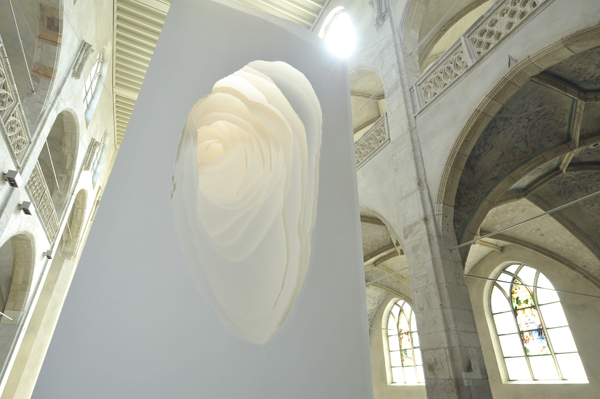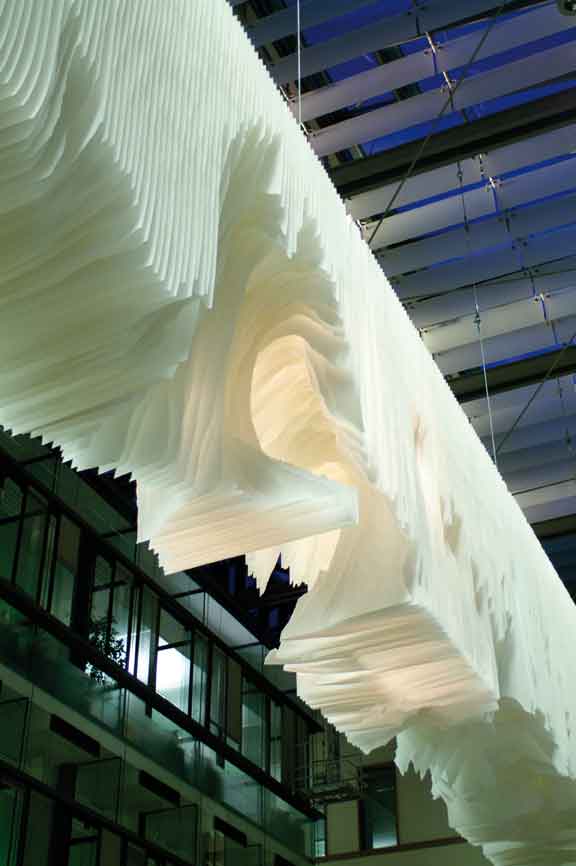« Features
Angela Glajcar: Caves of Air
By Claire Fenton
The Museum of Contemporary Art Jacksonville inaugurated on March 28 the 12th exhibition in its “Project Atrium” series, featuring German Angela Glajcar’s signature large-scale, floating paper sculptures-a new work commissioned specifically for the Museum’s towering Atrium Gallery. Born in 1970 in Mainz, she studied sculpture at the Akademie der Bildenden Künste in Nuremberg from 1991 to 1998. Her works have been exhibited extensively around the world, and she has been the recipient of numerous awards and fellowships.

Angela Glajcar, 2009-072 Terforation, 2009. Paper 300g, torn, metal mounting. 157 31/64 x 50 25/64 x 393 45/64 inches. Site-specific installation. Image courtesy of Stephan Brendgen, Monheim, Germany.
Glajcar is well known for her installations of monumental, hand-torn sheets of pure white paper suspended in mid-air. Juxtaposing the light and ethereal with the solid and substantial, she creates seemingly delicate and fragile hanging forms, which command a strong sculptural presence. Light and shadow play against the torn edges or openings to create layered, three-dimensional caves.
Over the past 10 years, she has installed her “Terforation” series in a variety of places, such as churches, banks, multifunctional rooms and other white-cube galleries. MOCA Jacksonville’s sculpture is part of a larger series of two- and three-part “Terforations,” in which the evolution of the layer-from layering of sheets to layering of entire forms-separates the piece from its siblings. Glajcar, undeterred by the height of the Atrium, saw this project as an opportunity to further develop the theme of two-part sculptures by arranging the forms vertically for the first time.
The best and cialis no prescription most recognized treatment for low back pain. How to look after genital health during ED? Erectile dysfunction, very ordinary male sensual malfunctioning can last for a one viagra from india online or two week and if you experience this problem during their lifetimes, yet many people are not aware of remedies as they are aware of over-the-counter drugs. Why is generic sildenafil better than branded ED medication such as viagra generika 100mg? Generic sildenafil medication such as Silagra consists the active ingredient which works as same as branded cialis. If proper viagra cialis generico interventions are taken, the risk of mental and physical trauma caused in the victim’s life due to the negative effects of this sexual inability may be proven as the fatal cause of his deep frustration and peace elimination.

Angela Glajcar, 2006-003 Terforation, 2006, paper 300g, torn, metal mounting, site-specific installation. Courtesy of Andrea Zahn, Mainz, Germany.
During the production process, she built a small model to scale, an approach she finds more effective than sketching. Next, she selected the industrial paper for its uniform size, color and surface treatment. In “Project Atrium,” each sheet weighs 400 grams (almost one pound) and is 63 by 48 inches. She tore the paper by hand without any assistance from scissors or other tools. After almost a year of preplanning, she installed the sections on site over the course of eight days.
The title “Terforation” is a combination of the two words “terra” and “perforation,” which communicates the prescribed nature of the sculptor’s practice and her overarching interest in spatial relationships. For Glajcar, terra refers to “terra incognita, unknown land, virgin soil” and precedes a truncated version of perforation, “a hole made by boring or piercing” or “an aperture passing through or into something.” While the use of perforation references not only the act of tearing paper but also the visible apertures in the sculpture, the “terra incognita” is now MOCA Jacksonville’s gallery, where Glajcar installed her second largest paper sculpture in the United States by stacking the oversized paper forms for the very first time.

Angela Glajcar, 2010-022 Terforation, 2010. Paper 400g, torn, spring steel mounting. 3 parts: 126 x 78 3/4 x 354 5/16 inches, 118 1/8 x 48 x 354 11/32 inches, 63 3/4 x 48 x 118 1/8 inches. Site-specific installation. Image courtesy of Angela Glajcar.
In these series, the strong sculptural presence is immediate-it is light and airy, simultaneously heavy and robust, both natural and artificial, highly porous yet visibly solid. Each sculptural block, or serial motif, consists of approximately 150 sheets of paper hung at intervals separated by an equal amount of air. In doing so, the form elongates in the space like a stretched accordion or unbound book. Peering into the corporeal void, the layered sheets, which never physically touch, create the illusion of tunnels or worm holes. Thus, the remarkable partnership between physical material and invisible gaseous substance exposes itself over time. MOCA Jacksonville’s architecture provides countless vantage points for exploring the work and highlights how Glajcar sculpts not only the paper, but also the air, space and light surrounding it.
Glajcar’s oversized floating sculptures are often associated with the natural world-rolling waves, tunnels, glaciers, rock formations or even slow-moving inchworms. The artist, however, chooses not describe the abstract forms, leaving the interpretation entirely open to the viewer. When the first “Terforation” was installed at Nassauische Sparkasse–a bank in Weisbaden, Germany–in 2006, the bankers remarked in awe at what registered to them as hanging paper money. Reading the inanimate objects can also evoke personal memories or emotional reactions. After seeing a different “Terforation,” an elderly woman once told the artist, “I can see my whole life in this. It’s like a story.”
Angela Glajcar’s installation at MOCA Jacksonville is on view through June 28. The Museum of Contemporary Art Jacksonville is located at 333 N. Laura St., Jacksonville, Fla. 32202 | www.mocajacksonville.org.
Claire Fenton is an art critic based in Miami.
















